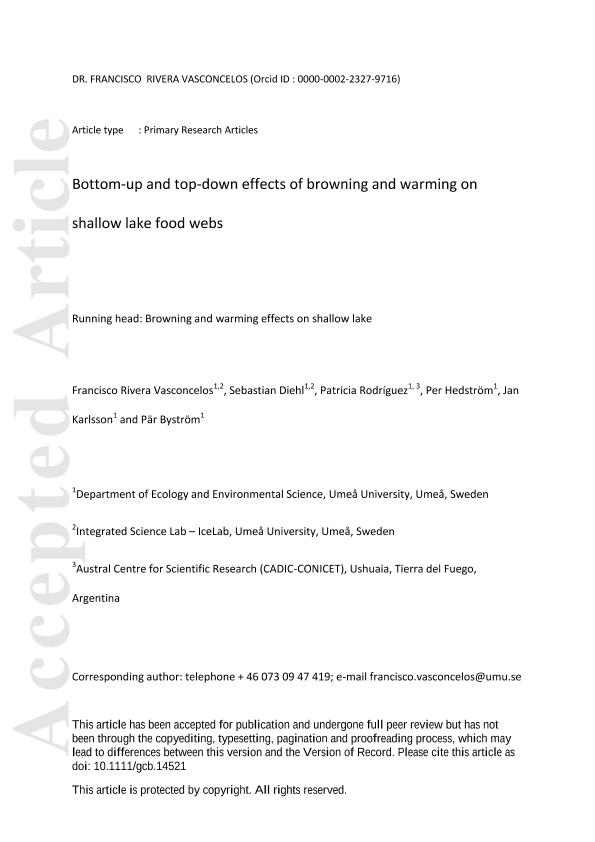Mostrar el registro sencillo del ítem
dc.contributor.author
Rivera Vasconcelos, Francisco
dc.contributor.author
Diehl, Sebastian
dc.contributor.author
Rodriguez, Patricia Laura

dc.contributor.author
Hedström, Per
dc.contributor.author
Karlsson, Jan
dc.contributor.author
Byström, Pär
dc.date.available
2020-10-26T14:53:46Z
dc.date.issued
2019-03
dc.identifier.citation
Rivera Vasconcelos, Francisco; Diehl, Sebastian; Rodriguez, Patricia Laura; Hedström, Per; Karlsson, Jan; et al.; Bottom-up and top-down effects of browning and warming on shallow lake food webs; Wiley Blackwell Publishing, Inc; Global Change Biology; 25; 2; 3-2019; 504-521
dc.identifier.issn
1354-1013
dc.identifier.uri
http://hdl.handle.net/11336/116807
dc.description.abstract
Productivity and trophic structure of aquatic ecosystems result from a complex interplay of19 bottom-up and top-down forces that operate across benthic and pelagic food web compartments.20 Projected global changes urge the question how this interplay will be affected by browning21 (increasing input of terrestrial dissolved organic matter), nutrient enrichment and warming. We22 explored this with a process-based model of a shallow lake food web consisting of benthic and23 pelagic components (abiotic resources, primary producers, grazers, carnivores), and compared24 model expectations with the results of a browning and warming experiment in nutrient-poor25 ponds harboring a boreal lake community. Under low nutrient conditions, the model makes three26 major predictions. (1) Browning reduces light and increases nutrient supply; this decreases27 benthic and increases pelagic production, gradually shifting productivity from the benthic to the28 pelagic habitat. (2) Because of active habitat choice, fish exert top-down control on grazers and29 benefit primary producers primarily in the more productive of the two habitats. (3) Warming30 relaxes top-down control of grazers by fish and decreases primary producer biomass, but effects31 of warming are generally small compared to effects of browning and nutrient supply.32 Experimental results were consistent with most model predictions for browning: light penetration,33 benthic algal production, and zoobenthos biomass decreased, and pelagic nutrients and pelagic34 algal production increased with browning. Also consistent with expectations, warming had35 negative effects on benthic and pelagic algal biomass and weak effects on algal production and36 zoobenthos and zooplankton biomass. Inconsistent with expectations, browning had no effect on37 zooplankton and warming effects on fish depended on browning. The model is applicable also to38 nutrient-rich systems, and we propose that it is a useful tool for the exploration of the39 consequences of different climate change scenarios for productivity and food web dynamics in40 shallow lakes, the worldwide most common lake type.
dc.format
application/pdf
dc.language.iso
eng
dc.publisher
Wiley Blackwell Publishing, Inc

dc.rights
info:eu-repo/semantics/openAccess
dc.rights.uri
https://creativecommons.org/licenses/by-nc-sa/2.5/ar/
dc.subject
BENTHIC AND PELAGIC HABITATS
dc.subject
BOTTOM-UP AND TOP-DOWN CONTROL
dc.subject
BROWNING
dc.subject
FOOD WEBS
dc.subject
LIGHT AND NUTRIENTS
dc.subject
SHALLOW LAKE
dc.subject
TOP PREDATOR
dc.subject
WARMING
dc.subject.classification
Biología Marina, Limnología

dc.subject.classification
Ciencias Biológicas

dc.subject.classification
CIENCIAS NATURALES Y EXACTAS

dc.title
Bottom-up and top-down effects of browning and warming on shallow lake food webs
dc.type
info:eu-repo/semantics/article
dc.type
info:ar-repo/semantics/artículo
dc.type
info:eu-repo/semantics/publishedVersion
dc.date.updated
2020-04-24T18:01:57Z
dc.journal.volume
25
dc.journal.number
2
dc.journal.pagination
504-521
dc.journal.pais
Reino Unido

dc.journal.ciudad
Londres
dc.description.fil
Fil: Rivera Vasconcelos, Francisco. Umea University. Department of Ecology and Environmental Science; Suecia
dc.description.fil
Fil: Diehl, Sebastian. Umea University. Department of Ecology and Environmental Science; Suecia
dc.description.fil
Fil: Rodriguez, Patricia Laura. Consejo Nacional de Investigaciones Científicas y Técnicas. Centro Austral de Investigaciones Científicas; Argentina
dc.description.fil
Fil: Hedström, Per. Umea University. Department of Ecology and Environmental Science; Suecia
dc.description.fil
Fil: Karlsson, Jan. Umea University. Department of Ecology and Environmental Science; Suecia
dc.description.fil
Fil: Byström, Pär. Umea University. Department of Ecology and Environmental Science; Suecia
dc.journal.title
Global Change Biology

dc.relation.alternativeid
info:eu-repo/semantics/altIdentifier/doi/https://doi.org/10.1111/gcb.14521
dc.relation.alternativeid
info:eu-repo/semantics/altIdentifier/url/https://onlinelibrary.wiley.com/doi/abs/10.1111/gcb.14521
Archivos asociados
